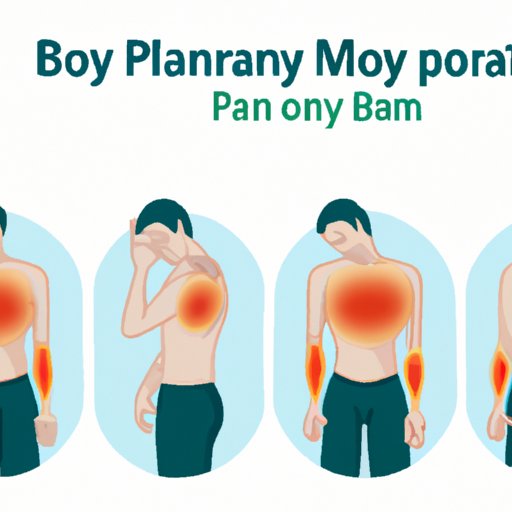Introduction
Body pain is a common experience that affects many people. Whether it’s a dull ache or sharp pain, it can have a significant impact on daily life, making it difficult to perform simple tasks or activities. This article aims to educate and empower readers to understand the causes of body pain and to provide tools for managing it effectively.
7 Common Causes of Body Pain and How to Alleviate Them
Muscular pain and strain from overuse or injury
Muscle pain and strain can occur from overuse or injury, such as carrying heavy bags or from performing repetitive motions. Treatment options include rest, stretching, and physical therapy. Applying heat or ice can also help to alleviate symptoms.
Arthritis and joint pain
Arthritis refers to pain and inflammation in the joints, and commonly affects older adults. Treatment options include medication, physical therapy, and joint replacement surgery in severe cases.
Fibromyalgia and chronic fatigue syndrome
These conditions cause widespread pain and fatigue. Treatment plans may include medication, cognitive behavioral therapy, and exercise programs.
Migraines and headaches
Headaches and migraines can be caused by many factors including stress, dehydration, or hormonal imbalances. Treatment options include preventative medication, relaxation techniques, and managing triggers.
Endometriosis and menstrual cramps
Endometriosis refers to a painful condition where the tissue that lines the uterus grows outside of it. Painful menstrual cramps are also quite common. Treatment options include hormonal therapy, pain medication, and surgery.
Cancer and cancer treatment
Cancer can cause many different types of pain, and managing pain is an important part of cancer treatment. Treatment options often include a combination of medication and alternative therapies like acupuncture or massage.
Poor posture and spinal misalignment
Poor posture and spinal misalignment can cause pain in the neck, back, and hips. Physical therapy, chiropractic care, and exercise can all help to address these issues and alleviate pain.
Is Your Lifestyle Contributing to Your Body Pain? Here’s What to Look For
Sedentary lifestyle and lack of physical activity
A sedentary lifestyle and lack of physical activity can cause pain and stiffness in the muscles and joints. Incorporating regular exercise and movement into your daily routine can help improve flexibility and reduce pain.
Poor diet and lack of proper nutrition
A poor diet lacking in essential vitamins and minerals can also contribute to body pain. Eating a balanced diet with plenty of fruits, vegetables, and protein can help reduce inflammation and support healthy joints.
Dehydration and its effect on body pain
Dehydration can cause headaches and muscle cramps. Aim to drink plenty of water throughout the day to stay hydrated.
Smoking and its impact on chronic pain
Smoking can worsen chronic pain conditions by reducing blood flow and increasing inflammation. Quitting smoking can help reduce pain and improve overall health.
The Link Between Chronic Stress and Physical Pain: Understanding the Connection
The impact of stress on the body’s nervous system
Chronic stress can cause physical changes in the body, including increased muscle tension and inflammation. Over time, this can lead to chronic pain conditions.
How stress contributes to chronic pain conditions
Stress can also worsen existing pain conditions, making it essential to manage stress as part of an effective pain management plan.
Techniques to manage and reduce stress
Effective stress-management techniques can include meditation, deep breathing exercises, and physical activity. Incorporating these practices into your daily routine can help reduce stress and alleviate pain.
What Your Body Pain Is Trying to Tell You: How to Listen to Your Body’s Signals
The importance of listening to your body
Listening to your body can help you identify when something isn’t right and can allow you to seek help before the issue worsens.
Understanding the different types of body pain
There are many different types of body pain, including acute pain, which comes on suddenly and often goes away after a short time, and chronic pain, which can last for months or even years.
How to identify and address the root cause of your body pain
Taking notes about when and where pain occurs, and tracking any related symptoms, can help you and your healthcare provider identify the underlying cause of your pain and develop a targeted treatment plan.
5 Natural Remedies for Body Pain That Actually Work
The benefits of natural remedies
Natural remedies can offer additional support for pain relief and work well in combination with traditional treatment options, like medication and physical therapy.
Examples of natural remedies for body pain
Some natural remedies you can try include heat therapy, massage, acupuncture, and herbal supplements. Always consult with your healthcare provider before trying any new treatment.
Physical Therapy vs. Medication for Body Pain: Which Option Is Right for You?
The benefits and drawbacks of physical therapy and medication
Physical therapy can help improve strength and flexibility, while medications can address pain relief and inflammation. Understanding the benefits and drawbacks of each option can help you make an informed decision.
When to consider physical therapy
Physical therapy can be very effective for managing chronic pain and improving overall mobility. It’s often recommended as a first-line treatment for musculoskeletal pain.
When to turn to medication
Medications are often prescribed for short-term pain relief, such as after an injury or surgical procedure. If pain persists, your healthcare provider may consider longer-term pain management options, like physical therapy.
Conclusion
Body pain can be a complex issue, but with the right tools and strategies, you can effectively manage and reduce pain. By understanding the causes of pain, adopting healthy lifestyle habits, and seeking help when necessary, it’s possible to improve quality of life and overall health.
If you’re experiencing body pain, remember that you don’t have to suffer in silence. Talk to your healthcare provider to develop a personalized pain management plan and empower yourself to take control of your health.
